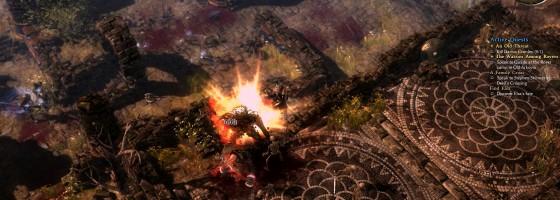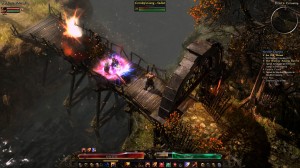Grim Dawn is finally out: The spiritual successor to Titan Quest made by Crate Entertainment has been in development for years now. After a successful crowd-funding campaign and then stint on Early Access, it’s time to talk about the game for real. Since Grim Dawn’s original announcement, ARPG design has seen a number of big name games released, but there is plenty of old and new in the game to get ARPG fans excited.
The Crack of Dawn:
The story is that the world has been plunged into darkness due to an eldritch attack that has render most of humanity dead or risen as undead. Creatures called the aetherials have taken over and the few pockets of humanity left are forced to fend for themselves. You play someone who was possessed by one of them who was freed just before dying; now you must brave the land and try to save the world.
For fans of Titan Quest, much of Grim Dawn’s main systems have returned here. Instead of having fixed classes like Diablo, you’ll choose 2 masteries that will give you skills in order to survive. You are free to mix and match from all available masteries; if you want to be a magic user who can also bash enemies with shields, feel free.
The game space is set each time you play, with slight permutations built around blocking off certain paths with each new game generation. As with any ARPG, you’re going to be fighting waves of enemies, looking for powerful loot and of course growing stronger; it’s the same cycle that has become the standard of the genre.
What separates Grim Dawn from recent examples like Diablo 3 is an adherence to older ARPG design similar to Path of Exile.
Old and New School:
Fans of classic ARPGs such as Titan Quest and of course Diablo 2 should feel right at home with Grim Dawn. Diablo 3 has certainly become the current king of the genre, but it’s a different flavor compared to Grim Dawn. Diablo 3’s experience has been refined and processed to becoming very mechanical. The designers have the entire experience controlled from beginning to end with how loot is generated and what enemies you will be fighting. That also extends to the classes which are locked to their respective skills and possible gear usage in the form of sets.
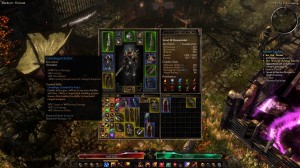
The loot tables are a lot more varied here compared to Diablo 3; allowing for more variety and utility
Grim Dawn doesn’t do that, and the game is a lot more “fiddly” in terms of player choices.
Instead of forcing you down the same paths with exclusive and powerful skills, the skills in Grim Dawn are more about a bag of tricks that you can define for yourself; two players choosing the same masteries can have completely different takes on their character.
Once unlocked, many skills can be improved further by adding skill points to them; increasing their potency at the cost of unlocking new skills along the mastery.
Behind the scenes, there is a lot going on with how damage and defense is calculated. Elemental damage and resistances are a big deal, as well as deciding where to allocate attribute points in order to use specific gear. As with Titan Quest, you can find components that can be attached to specific gear types to further augment them and give you an additional skill to use.
A lot of what makes Grim Dawn a breath of fresh air is the level of which the player can define their character with choices that matter, and you can look no further than the new Devotion system. As you explore the world, you may find shrines that you can restore to earn devotion points.
The devotion chart is a massive astrology page that allows you to assign these points to various constellations. Completing constellations will give you points in different categories that let you access other constellations. Some of them have special celestial powers that can be unlocked and assigned to skills of your choosing, and these can be game changers.
Loot design also goes back to older ARPGs: Where the loot tables are a lot wider and more random in terms of possible loot drops. You can find level 12 gear that is actually weaker than level 4, and so many modifiers to keep track of. Higher rarity gear can also give you additional skills or have the chance of doing something special; further making the choice of what to wear that much harder. Once you have some elite loot and skills under your belt, the screen can fill all manner of effects and bodies flying from your powers.
Grim Dawn is also more challenging than Diablo 3 thanks to changing the enemy scaling. Unlike D3 where enemies are always scaled to your level, Grim Dawn may scale enemies higher depending on the area you’re in. Instead of having elite packs, hero units can spawn with nasty effects and are of course harder to kill.
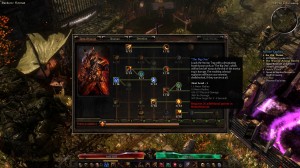
While masteries feature set choices, you are free to mix and match their abilities to your heart’s content
Grim Dawn’s old school flavor helps it stand out when compared to Diablo 3, but it’s this adherence that does hurt the game in some respect.
Back in Time:
Grim Dawn is a continuation of Titan Quest which in of itself was based on Diablo 2’s design and foundation, but the problem is that ARPG design has evolved since then.
Diablo 3 may not be perfect, but it did a lot to streamline ARPG design and make it accessible to a wider audience.
Grim Dawn doesn’t go in that direction and presents a game with a higher difficulty and learning curve. Diablo 3’s skill system and ability to mix and match at any time was great to present choice without punishing the wrong decision. Grim Dawn however goes back to the older way of letting the player pick everything and can lead to them causing problems. While you can respec some aspects of your character, the game is still about you making difficult choices before you really understand what they mean.
Grim Dawn’s presentation is a part of this problem; both from an aesthetics and design point of view. There are a lot of details to keep track of, and the game doesn’t do a good job of showing these to the player. Diablo 3 these days shows you clearly if a piece of gear is better or comparable to what you’re wearing, and Grim Dawn doesn’t. Skills are broken down neatly to show you just what exactly will it do and how much damage, while Grim Dawn shows you everything. While experts can argue that it gives the game more complexity, it also makes things confusing.
For instance, the game doesn’t tell you what’s the difference between different elemental types, and advanced information is hidden deep on your character sheet. The devotion system is a great way of enhancing your character and providing reason to explore the world, but it’s laid out horribly for someone new to try and parse through it. As with older ARPGs, you’ll assign attribute points with each new level, but a new player won’t know why they should put more into cunning over spirit or vice versa.
Loot design also presents this problem. The greater range of loot attributes can lead to an overflow of loot; confusing the player as to what is the best out of everything they have. As another example, there is a difference between the attribute that adds flat elemental damage and the one that transforms X % of your attack damage to an elemental type, but the game never explains what that is or makes it easy to break that information down. Loot screens can become a garbled mess of attributes stretching from the top of the screen to the bottom as you try to make sense out of which is supposedly better for you.
Finally there is the presentation of the game. While Grim Dawn does look better than Titan Quest, it’s still behind the curve compared to Diablo 3. To be fair, we’re comparing an Indie studio to one of the biggest ones on the planet, but Grim Dawn lacks a distinguishing aesthetic style to help it stand out. Many enemies of the same type look almost exactly to each other, and specialized enemies who are far more dangerous tend to blend into the crowd. It’s very easy to be fighting a group of enemies and take massive damage to one enemy and not know why because of this.
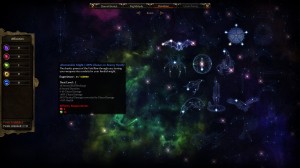
The Devotion system is one of many examples of the game overwhelming players with choices and information without any way to decipher it.
While it may be debatable, Diablo 3 does have a clear aesthetic that makes it easy to spot special enemies, avoid effects and gauge the threat level of an enemy group.
There is just this certain sense of rawness to Grim Dawn compared to Diablo 3; in turn, gives it a different flavor to it.
If Diablo 3’s streamlined design has won you over, you may not like the trip to the past that Grim Dawn presents. However, if you’re looking for an ARPG that gives you the freedom to grow and make your own mistakes, Grim Dawn is that game.
A Bright Day:
Grim Dawn has been a long time coming and shows a level of passion and dedication from Crate Entertainment. What we have is a love letter to the ARPG genre and one that I hope does well for them. While the genre has grown differently since the days of Titan Quest, Grim Dawn still presents that ever popular cycle of loot and progression that has made the genre a winner. There are already talks of expansion and continued content; so who knows, maybe one day it will also have a major “Patch 2.0” of its own.
For more on Grim Dawn, you can check out my playlist of hardcore plays with different characters.

